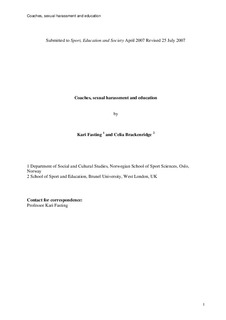| dc.contributor.author | Fasting, Kari | |
| dc.contributor.author | Brackenridge, Celia H. | |
| dc.date.accessioned | 2010-02-03T13:33:59Z | |
| dc.date.issued | 2009-02 | |
| dc.identifier | Seksjon for kultur og samfunn / Department of Cultural and Social Studies | |
| dc.identifier.citation | Sport, Education and Society. 2009, 14(1), 21-35 | en |
| dc.identifier.issn | 1357-3322 | |
| dc.identifier.uri | http://hdl.handle.net/11250/170753 | |
| dc.description | I Brage finner du siste tekst-versjon av artikkelen, og den kan inneholde ubetydelige forskjeller fra forlagets pdf-versjon. Forlagets pdf-versjon finner du på www.informaworld.com: http://dx.doi.org/10.1080/13573320802614950 / In Brage you'll find the final text version of the article, and it may contain insignificant differences from the journal's pdf version. The original publication is available at www.informaworld.com: http://dx.doi.org/10.1080/13573320802614950 | en |
| dc.description.abstract | Sexual harassment in sport has become an active research field within the past decade yet we know relatively little about the characteristics of the harassing coach. How are harassing coaches characterised by their victims, that is, the athletes themselves? Do they demonstrate specific kinds of behaviours? One purpose of this article is to address these types of questions. Another is to assess the usefulness of general classifications of perpetrators of sexual harassment. This is done by examining whether qualitative data from sexually harassed elite female athletes support the various conceptual frameworks for sexual harassment that are presented. Results from interviews with 19 female elite athletes who were sexually harassed by their coaches produced a sport typology that consists of three main types: (1) The Flirting-Charming Coach; (2) The Seductive Coach; and (3) The Authoritarian Coach. These types are discussed in relation to the previous classifications to test the degree of fit. The limitations of monolithic classifications are exposed by this exercise: the data suggest that, rather than being one-type only, sexually harassing coaches select from a repertoire that may include several different harassment scripts. They vary these according to situational conditions. The wider limitation of social science classifications, that their categories are not discrete, also applies here. This need not be a practical limitation, however, if the typologies are used as heuristic devices rather than to determine, for example, specific disciplinary outcomes or treatment regimes. Sexual harassment prevention is often either missing from coach education programmes altogether or subsumed within broader themes such as (gender) equity or diversity management. One of the educational values of typologies is that they focus attention on the range of potential sexually harassing behaviours in ways which might otherwise escape attention. Communication styles, postures, gestures and group management techniques are just some of the elements of coaching that can be improved with an understanding of sexual harassment scripts. It is difficult to assess whether feminisation of the coaching profession would lead to a less harassing environment. But, since this environment is so closely linked to hegemonic masculinity, and what are often described as traditional male values, we hypothesise that a transformation of the coaching culture, and associated re-scripting of coach behaviour, might be easier if more female coaches were involved in sport. | en |
| dc.format.extent | 85613 bytes | |
| dc.format.mimetype | application/pdf | |
| dc.language.iso | eng | en |
| dc.publisher | Routledge | en |
| dc.subject | sexual harassment | en |
| dc.subject | female athletes | en |
| dc.subject | classification | en |
| dc.subject | script | en |
| dc.subject | coach education | en |
| dc.title | Coaches, sexual harassment and education | en |
| dc.type | Peer reviewed | en |
| dc.type | Journal article | en |
| dc.subject.nsi | VDP::Social science: 200::Social science in sports: 330::Other subjects within physical education: 339 | en |
| dc.source.pagenumber | 21-35 | en |
| dc.source.volume | 14 | en |
| dc.source.journal | Sport, Education and Society | en |
| dc.source.issue | 1 | en |
